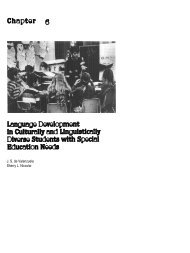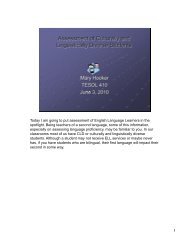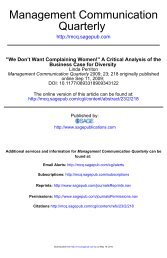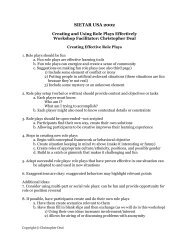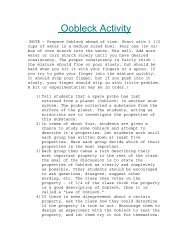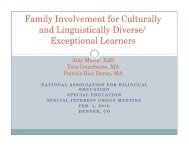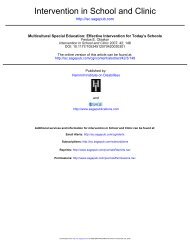40 Assets List-Infants - Crosscultural Developmental Education ...
40 Assets List-Infants - Crosscultural Developmental Education ...
40 Assets List-Infants - Crosscultural Developmental Education ...
You also want an ePaper? Increase the reach of your titles
YUMPU automatically turns print PDFs into web optimized ePapers that Google loves.
<strong>40</strong> <strong>Developmental</strong> <strong>Assets</strong>for <strong>Infants</strong>Search Institute has identified the following building blocks of healthydevelopment that help infants grow up healthy, caring, and responsible.External <strong>Assets</strong>CategorySupportEmpowermentBoundaries &ExpectationsConstructiveUse of TimeAsset Name and Definition1. Family Support-Family life provides high levels of love and support.2. Positive Family Communication-Parents communicate with infants in positive ways.Parents respond immediately to infants and respect their needs.3. Other Adult Relationships-Parents have support from three or more adults and askfor help when needed. <strong>Infants</strong> receive additional love and comfort from at least oneadult other than their parents.4. Caring Neighborhood-<strong>Infants</strong> experience caring neighbors.5. Caring Out-Of-Home Climate-<strong>Infants</strong> are in caring, encouraging environmentsoutside the home.6. Parent Involvement in Out-of-Home Situations-Parents are actively involved incommunicating infants’ needs to situations caretakers and others in situations outsidethe home.7. Community Values Children-The family places infants at the center of family life.Other adults in the community value and appreciate infants.8. Children are Given Useful Roles-The family involves infants in family life.9. Service to Others-Parents serve others in the community.10. Safety-<strong>Infants</strong> have safe environments at home, in out-of-home settings, and in theneighborhood. This includes childproofing these environments.11. Family Boundaries-Parents are aware of infants’ preferences and adapt theenvironment and schedule to suit infants’ needs. Parents begin setting limits as infantsbecome mobile.12. Out-of-Home Boundaries-Childcare settings and other out-of-home environmentshave clear rules and consequences for older infants and consistently provide allinfants with appropriate stimulation and enough rest.13. Neighborhood Boundaries-Neighbors take responsibility for monitoring andsupervising infants’ behavior as they begin to play and interact outside the home.14. Adult Role Models-Parents and other adults model positive, responsible behavior.15. Positive Peer Observation-<strong>Infants</strong> observe siblings and other children interacting inpositive ways. They have opportunities to interact with children of various ages.16. Appropriate Expectations for Growth-Parents have realistic expectations for infants’development at this age. Parents encourage development without pushing infantsbeyond their own pace.17. Creative Activities-Parents expose infants to music, art, or other creative aspects ofthe environment each day.18. Out-of-Home Activities-Parents expose infants to limited but stimulating situationsoutside the home. The family keeps infants’ needs in mind when attending events.19. Religious Community-The family regularly attends religious programs or serviceswhile keeping infants’ needs in mind.20. Positive, Supervised Time at Home- Parents supervise infants at all times andprovide predictable, enjoyable routines at home.This page may be reproduced for educational, noncommercial uses only.Copyright © 2003 by Search Institute, 615 First Ave NE, Suite 125, Minneapolis, MN 55413; 800-888-7828; www.search-institute.org.
Internal <strong>Assets</strong>Commitment toLearningPositive ValuesSocialCompetenciesPositiveIdentity21. Achievement Expectation and Motivation-Family members are motivated to dowell at work, at school, and in the community, and model their motivation forinfants.22. Children are Engaged in Learning-Parents and family members model responsiveand attentive attitudes at work, at school, in the community, and at home..23. Stimulating Activity-Parents encourage infants to explore and provide stimulatingtoys that match infants’ emerging skills. Parents are sensitive to infants’dispositions, preferences, and level of development.24. Enjoyment of Learning-Parents enjoy learning and model this through their ownlearning activities.25. Reading for Pleasure-Parents read to infants in enjoyable ways every day.26. Family Values Caring-Parents convey their beliefs about helping others bymodeling their helping behaviors.27. Family Values Equality and Social Justice- Parents place a high value onpromoting social equality, religious tolerance, and reducing hunger and povertywhile modeling these beliefs for infants.28. Family Values Integrity-Parents act on their convictions, stand up for their beliefs,and communicate and model this in the family.29. Family Values Honesty-Parents tell the truth and convey their belief in honestythrough their actions.30. Family Values Responsibility-parents accepts and takes personal responsibility.31. Family Values Healthy Lifestyle-Parents love children, setting the foundation forinfants to develop healthy attitudes and beliefs about relationships. Parents model,monitor, and teach the importance of good health habits, and provide goodnutritional choices and adequate rest and playtime.32. Planning and Decision Making Observation-Parents make all safety and caredecisions for infants and model safe behavior. As infants become moreindependently mobile, parents allow them to make simple choices.33. Interpersonal Observation-Parents model positive, constructive interactions withother people. Parents accept and are responsive to how infants express theirfeelings, seeing those expressions as cues to infants’ needs.34. Cultural Observation-Parents know and are comfortable with people of differentcultural, racial, and/or ethnic backgrounds, and model this to infants.35. Resistance Observation-Parents model resistance skills through their own behavior.36. Peaceful Conflict Resolution Observation-Parents behave in acceptable,nonviolent ways and assist infants in developing these skills by helping them solveproblems when they’re faced with challenging or frustrating circumstances.37. Family Has Personal Power-Parents feel they have control over things that happenin their own lives and model coping skills, demonstrating healthy ways to dealwith frustrations and challenges. Parents respond to infants so infants begin tolearn that they have influence over their immediate surroundings.38. Family Models High Self-Esteem-Parents create an environment where infants candevelop positive self-esteem, giving infants appropriate, positive feedback andreinforcement about their skills and competencies.39. Family Has a Sense of Purpose-Parents report that their lives have purpose anddemonstrate these beliefs through their behaviors. <strong>Infants</strong> are curious about theworld around them.<strong>40</strong>. Family has a Positive View of Personal Future-Parents are hopeful and positiveabout their personal future and work to provide a positive future for children.This page may be reproduced for educational, noncommercial uses only.Copyright © 2003 by Search Institute, 615 First Ave NE, Suite 125, Minneapolis, MN 55413; 800-888-7828; www.search-institute.org.



